+ Open data
Open data
- Basic information
Basic information
| Entry | Database: PDB / ID: 8shg | ||||||||||||||||||||||||||||||||||||||||||||||||||||||
|---|---|---|---|---|---|---|---|---|---|---|---|---|---|---|---|---|---|---|---|---|---|---|---|---|---|---|---|---|---|---|---|---|---|---|---|---|---|---|---|---|---|---|---|---|---|---|---|---|---|---|---|---|---|---|---|
| Title | CCT G beta 5 complex closed state 9 | ||||||||||||||||||||||||||||||||||||||||||||||||||||||
 Components Components |
| ||||||||||||||||||||||||||||||||||||||||||||||||||||||
 Keywords Keywords | CHAPERONE / CCT / Gb5 / complex / open | ||||||||||||||||||||||||||||||||||||||||||||||||||||||
| Function / homology |  Function and homology information Function and homology informationheterotrimeric G-protein complex assembly / GTPase activator complex / dark adaptation / light adaption / G-protein gamma-subunit binding / negative regulation of voltage-gated calcium channel activity / zona pellucida receptor complex / positive regulation of establishment of protein localization to telomere / positive regulation of protein localization to Cajal body / scaRNA localization to Cajal body ...heterotrimeric G-protein complex assembly / GTPase activator complex / dark adaptation / light adaption / G-protein gamma-subunit binding / negative regulation of voltage-gated calcium channel activity / zona pellucida receptor complex / positive regulation of establishment of protein localization to telomere / positive regulation of protein localization to Cajal body / scaRNA localization to Cajal body / positive regulation of telomerase RNA localization to Cajal body / cell tip / tubulin complex assembly / chaperonin-containing T-complex / : / BBSome-mediated cargo-targeting to cilium / Formation of tubulin folding intermediates by CCT/TriC / binding of sperm to zona pellucida / Folding of actin by CCT/TriC / regulation of G protein-coupled receptor signaling pathway / cell projection organization / positive regulation of smoothened signaling pathway / Prefoldin mediated transfer of substrate to CCT/TriC / RHOBTB1 GTPase cycle / G protein-coupled dopamine receptor signaling pathway / WD40-repeat domain binding / parallel fiber to Purkinje cell synapse / pericentriolar material / Association of TriC/CCT with target proteins during biosynthesis / positive regulation of GTPase activity / chaperone-mediated protein complex assembly / Hydrolases; Acting on acid anhydrides; In phosphorus-containing anhydrides / RHOBTB2 GTPase cycle / beta-tubulin binding / heterochromatin / : / positive regulation of telomere maintenance via telomerase / visual perception / protein folding chaperone / acrosomal vesicle / Gene and protein expression by JAK-STAT signaling after Interleukin-12 stimulation / GTPase activator activity / mRNA 3'-UTR binding / cell projection / ATP-dependent protein folding chaperone / mRNA 5'-UTR binding / response to virus / G beta:gamma signalling through PLC beta / Presynaptic function of Kainate receptors / Thromboxane signalling through TP receptor / Activation of G protein gated Potassium channels / Inhibition of voltage gated Ca2+ channels via Gbeta/gamma subunits / G-protein activation / Prostacyclin signalling through prostacyclin receptor / G beta:gamma signalling through CDC42 / G beta:gamma signalling through BTK / ADP signalling through P2Y purinoceptor 12 / Glucagon-type ligand receptors / Adrenaline,noradrenaline inhibits insulin secretion / azurophil granule lumen / Vasopressin regulates renal water homeostasis via Aquaporins / Glucagon-like Peptide-1 (GLP1) regulates insulin secretion / G alpha (z) signalling events / ADP signalling through P2Y purinoceptor 1 / ADORA2B mediated anti-inflammatory cytokines production / G beta:gamma signalling through PI3Kgamma / Cooperation of PDCL (PhLP1) and TRiC/CCT in G-protein beta folding / unfolded protein binding / melanosome / GPER1 signaling / protein folding / Inactivation, recovery and regulation of the phototransduction cascade / G-protein beta-subunit binding / heterotrimeric G-protein complex / G alpha (12/13) signalling events / signaling receptor complex adaptor activity / Thrombin signalling through proteinase activated receptors (PARs) / protein-folding chaperone binding / cell body / presynaptic membrane / Ca2+ pathway / High laminar flow shear stress activates signaling by PIEZO1 and PECAM1:CDH5:KDR in endothelial cells / secretory granule lumen / G alpha (i) signalling events / G alpha (s) signalling events / G alpha (q) signalling events / ficolin-1-rich granule lumen / microtubule / postsynaptic membrane / cytoskeleton / Extra-nuclear estrogen signaling / protein stabilization / cilium / cadherin binding / GTPase activity / dendrite / ubiquitin protein ligase binding / centrosome / Neutrophil degranulation / Golgi apparatus Similarity search - Function | ||||||||||||||||||||||||||||||||||||||||||||||||||||||
| Biological species |  Homo sapiens (human) Homo sapiens (human) | ||||||||||||||||||||||||||||||||||||||||||||||||||||||
| Method | ELECTRON MICROSCOPY / single particle reconstruction / cryo EM / Resolution: 2.8 Å | ||||||||||||||||||||||||||||||||||||||||||||||||||||||
 Authors Authors | Wang, S. / Sass, M. / Willardson, B.M. / Shen, P.S. | ||||||||||||||||||||||||||||||||||||||||||||||||||||||
| Funding support |  United States, 1items United States, 1items
| ||||||||||||||||||||||||||||||||||||||||||||||||||||||
 Citation Citation |  Journal: Mol Cell / Year: 2023 Journal: Mol Cell / Year: 2023Title: Visualizing the chaperone-mediated folding trajectory of the G protein β5 β-propeller. Authors: Shuxin Wang / Mikaila I Sass / Yujin Kwon / W Grant Ludlam / Theresa M Smith / Ethan J Carter / Nathan E Gladden / Margot Riggi / Janet H Iwasa / Barry M Willardson / Peter S Shen /  Abstract: The Chaperonin Containing Tailless polypeptide 1 (CCT) complex is an essential protein folding machine with a diverse clientele of substrates, including many proteins with β-propeller domains. Here, ...The Chaperonin Containing Tailless polypeptide 1 (CCT) complex is an essential protein folding machine with a diverse clientele of substrates, including many proteins with β-propeller domains. Here, we determine the structures of human CCT in complex with its accessory co-chaperone, phosducin-like protein 1 (PhLP1), in the process of folding Gβ, a component of Regulator of G protein Signaling (RGS) complexes. Cryoelectron microscopy (cryo-EM) and image processing reveal an ensemble of distinct snapshots that represent the folding trajectory of Gβ from an unfolded molten globule to a fully folded β-propeller. These structures reveal the mechanism by which CCT directs Gβ folding through initiating specific intermolecular contacts that facilitate the sequential folding of individual β sheets until the propeller closes into its native structure. This work directly visualizes chaperone-mediated protein folding and establishes that CCT orchestrates folding by stabilizing intermediates through interactions with surface residues that permit the hydrophobic core to coalesce into its folded state. | ||||||||||||||||||||||||||||||||||||||||||||||||||||||
| History |
|
- Structure visualization
Structure visualization
| Structure viewer | Molecule:  Molmil Molmil Jmol/JSmol Jmol/JSmol |
|---|
- Downloads & links
Downloads & links
- Download
Download
| PDBx/mmCIF format |  8shg.cif.gz 8shg.cif.gz | 1.4 MB | Display |  PDBx/mmCIF format PDBx/mmCIF format |
|---|---|---|---|---|
| PDB format |  pdb8shg.ent.gz pdb8shg.ent.gz | 1.2 MB | Display |  PDB format PDB format |
| PDBx/mmJSON format |  8shg.json.gz 8shg.json.gz | Tree view |  PDBx/mmJSON format PDBx/mmJSON format | |
| Others |  Other downloads Other downloads |
-Validation report
| Summary document |  8shg_validation.pdf.gz 8shg_validation.pdf.gz | 2.3 MB | Display |  wwPDB validaton report wwPDB validaton report |
|---|---|---|---|---|
| Full document |  8shg_full_validation.pdf.gz 8shg_full_validation.pdf.gz | 2.4 MB | Display | |
| Data in XML |  8shg_validation.xml.gz 8shg_validation.xml.gz | 210.6 KB | Display | |
| Data in CIF |  8shg_validation.cif.gz 8shg_validation.cif.gz | 328.5 KB | Display | |
| Arichive directory |  https://data.pdbj.org/pub/pdb/validation_reports/sh/8shg https://data.pdbj.org/pub/pdb/validation_reports/sh/8shg ftp://data.pdbj.org/pub/pdb/validation_reports/sh/8shg ftp://data.pdbj.org/pub/pdb/validation_reports/sh/8shg | HTTPS FTP |
-Related structure data
| Related structure data |  40487MC  8sfeC 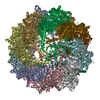 8sffC 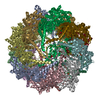 8sg8C 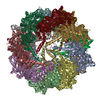 8sg9C 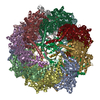 8sgcC 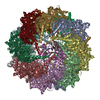 8sglC  8sgqC 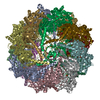 8sh9C 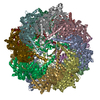 8shaC 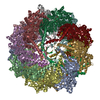 8shdC  8sheC  8shfC 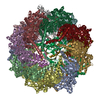 8shlC 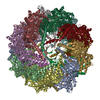 8shnC  8shoC  8shpC 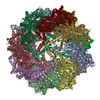 8shqC 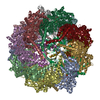 8shtC M: map data used to model this data C: citing same article ( |
|---|---|
| Similar structure data | Similarity search - Function & homology  F&H Search F&H Search |
- Links
Links
- Assembly
Assembly
| Deposited unit | 
|
|---|---|
| 1 |
|
- Components
Components
-Protein , 2 types, 2 molecules NP
| #1: Protein | Mass: 43619.297 Da / Num. of mol.: 1 / Source method: isolated from a natural source / Source: (natural)  Homo sapiens (human) / Cell line: HEK293T / Tissue: Kidney / References: UniProt: O14775 Homo sapiens (human) / Cell line: HEK293T / Tissue: Kidney / References: UniProt: O14775 |
|---|---|
| #10: Protein | Mass: 34322.527 Da / Num. of mol.: 1 / Source method: isolated from a natural source / Source: (natural)  Homo sapiens (human) / Cell line: HEK293T / Tissue: Kidney / References: UniProt: Q13371 Homo sapiens (human) / Cell line: HEK293T / Tissue: Kidney / References: UniProt: Q13371 |
-T-complex protein 1 subunit ... , 8 types, 16 molecules AaBbDdEeGgHhQqZz
| #2: Protein | Mass: 58243.172 Da / Num. of mol.: 2 / Source method: isolated from a natural source / Source: (natural)  Homo sapiens (human) / Cell line: HEK293T / Tissue: Kidney / References: UniProt: P17987 Homo sapiens (human) / Cell line: HEK293T / Tissue: Kidney / References: UniProt: P17987#3: Protein | Mass: 56490.855 Da / Num. of mol.: 2 / Source method: isolated from a natural source / Source: (natural)  Homo sapiens (human) / Cell line: HEK293T / Tissue: Kidney / References: UniProt: P78371 Homo sapiens (human) / Cell line: HEK293T / Tissue: Kidney / References: UniProt: P78371#4: Protein | Mass: 56242.168 Da / Num. of mol.: 2 / Source method: isolated from a natural source / Source: (natural)  Homo sapiens (human) / Cell line: HEK293T / Tissue: Kidney / References: UniProt: P50991 Homo sapiens (human) / Cell line: HEK293T / Tissue: Kidney / References: UniProt: P50991#5: Protein | Mass: 59618.754 Da / Num. of mol.: 2 / Source method: isolated from a natural source / Source: (natural)  Homo sapiens (human) / Cell line: HEK293T / Tissue: Kidney / References: UniProt: P48643 Homo sapiens (human) / Cell line: HEK293T / Tissue: Kidney / References: UniProt: P48643#6: Protein | Mass: 58837.996 Da / Num. of mol.: 2 / Source method: isolated from a natural source / Source: (natural)  Homo sapiens (human) / Cell line: HEK293T / Tissue: Kidney / References: UniProt: P49368 Homo sapiens (human) / Cell line: HEK293T / Tissue: Kidney / References: UniProt: P49368#7: Protein | Mass: 57939.809 Da / Num. of mol.: 2 / Source method: isolated from a natural source / Source: (natural)  Homo sapiens (human) / Cell line: HEK293T / Tissue: Kidney / References: UniProt: Q99832 Homo sapiens (human) / Cell line: HEK293T / Tissue: Kidney / References: UniProt: Q99832#8: Protein | Mass: 58427.164 Da / Num. of mol.: 2 / Source method: isolated from a natural source / Source: (natural)  Homo sapiens (human) / Cell line: HEK293T / Tissue: Kidney / References: UniProt: P50990 Homo sapiens (human) / Cell line: HEK293T / Tissue: Kidney / References: UniProt: P50990#9: Protein | Mass: 57719.613 Da / Num. of mol.: 2 / Source method: isolated from a natural source / Source: (natural)  Homo sapiens (human) / Cell line: HEK293T / Tissue: Kidney / References: UniProt: P40227 Homo sapiens (human) / Cell line: HEK293T / Tissue: Kidney / References: UniProt: P40227 |
|---|
-Non-polymers , 4 types, 67 molecules 

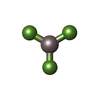




| #11: Chemical | ChemComp-ADP / #12: Chemical | ChemComp-MG / #13: Chemical | ChemComp-AF3 / #14: Water | ChemComp-HOH / | |
|---|
-Details
| Has ligand of interest | N |
|---|---|
| Has protein modification | N |
-Experimental details
-Experiment
| Experiment | Method: ELECTRON MICROSCOPY |
|---|---|
| EM experiment | Aggregation state: PARTICLE / 3D reconstruction method: single particle reconstruction |
- Sample preparation
Sample preparation
| Component | Name: CCT-Gb5-PhLP1 in closed state 9 / Type: COMPLEX / Entity ID: #1-#10 / Source: NATURAL | |||||||||||||||||||||||||||||||||||
|---|---|---|---|---|---|---|---|---|---|---|---|---|---|---|---|---|---|---|---|---|---|---|---|---|---|---|---|---|---|---|---|---|---|---|---|---|
| Molecular weight | Value: 947.77 kDa/nm / Experimental value: NO | |||||||||||||||||||||||||||||||||||
| Source (natural) | Organism:  Homo sapiens (human) / Organ: Kidney / Tissue: Kidney Homo sapiens (human) / Organ: Kidney / Tissue: Kidney | |||||||||||||||||||||||||||||||||||
| Source (recombinant) | Organism:  Homo sapiens (human) / Cell: HEK 293T Homo sapiens (human) / Cell: HEK 293T | |||||||||||||||||||||||||||||||||||
| Buffer solution | pH: 7.5 | |||||||||||||||||||||||||||||||||||
| Buffer component |
| |||||||||||||||||||||||||||||||||||
| Specimen | Conc.: 1.5 mg/ml / Embedding applied: NO / Shadowing applied: NO / Staining applied: NO / Vitrification applied: YES / Details: The sample was monodisperse | |||||||||||||||||||||||||||||||||||
| Vitrification | Instrument: FEI VITROBOT MARK I / Cryogen name: ETHANE / Humidity: 100 % / Chamber temperature: 277.15 K |
- Electron microscopy imaging
Electron microscopy imaging
| Experimental equipment |  Model: Titan Krios / Image courtesy: FEI Company |
|---|---|
| Microscopy | Model: TFS KRIOS |
| Electron gun | Electron source:  FIELD EMISSION GUN / Accelerating voltage: 300 kV / Illumination mode: FLOOD BEAM FIELD EMISSION GUN / Accelerating voltage: 300 kV / Illumination mode: FLOOD BEAM |
| Electron lens | Mode: BRIGHT FIELD / Nominal defocus max: 1200 nm / Nominal defocus min: 800 nm / Cs: 2.7 mm |
| Image recording | Electron dose: 40.42 e/Å2 / Film or detector model: GATAN K3 (6k x 4k) |
- Processing
Processing
| Software | Name: PHENIX / Version: 1.19.2_4158: / Classification: refinement | ||||||||||||||||||||||||
|---|---|---|---|---|---|---|---|---|---|---|---|---|---|---|---|---|---|---|---|---|---|---|---|---|---|
| EM software |
| ||||||||||||||||||||||||
| CTF correction | Type: PHASE FLIPPING AND AMPLITUDE CORRECTION | ||||||||||||||||||||||||
| 3D reconstruction | Resolution: 2.8 Å / Resolution method: FSC 0.143 CUT-OFF / Num. of particles: 120668 / Symmetry type: POINT | ||||||||||||||||||||||||
| Refine LS restraints |
|
 Movie
Movie Controller
Controller





















 PDBj
PDBj




























